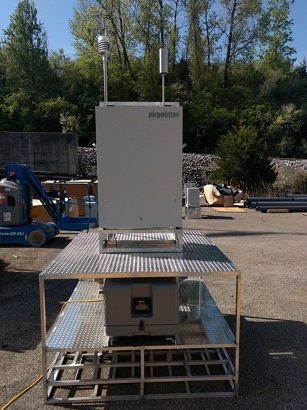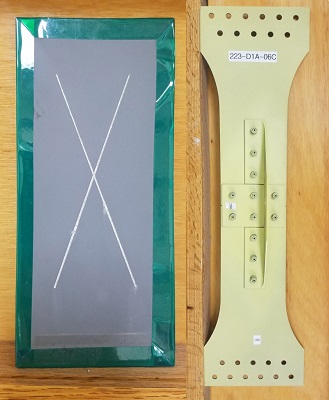The Air Force Research Laboratory (AFRL) (Wright-Patterson Air Force Base, Ohio, USA) says it is developing a new environmental sensing platform and testing chamber apparatus to enable superior management of aircraft corrosion.
Researchers from AFRL’s materials and manufacturing directorate are currently testing both devices, which they believe could help preemptively predict corrosive environmental conditions before they can cause damage to military assets.
Sensing Platform Features
Called the WISE-MP, which stands for Weather Instrumentation and Specialized Environmental Monitoring Platform,1 the sensing device can measure conditions that can be detrimental to aircraft, such as pollutants, salt, and moisture.
 The prototype device, which consists of a gas monitor, weather sensor, chloride monitor, and control box mounted on a sturdy aluminum frame, occupies a small footprint. It is portable, durable, and waterproof, with easy access to components. The platform is low-maintenance, according to AFRL officials, requiring only occasional filter changes and minor adjustments.
The prototype device, which consists of a gas monitor, weather sensor, chloride monitor, and control box mounted on a sturdy aluminum frame, occupies a small footprint. It is portable, durable, and waterproof, with easy access to components. The platform is low-maintenance, according to AFRL officials, requiring only occasional filter changes and minor adjustments.
The WISE-MP control unit stores and transmits data for remote monitoring, and data can be accessed on site as well. “It is a complete sensing platform that can provide relevant environmental data for installations where aircraft are housed,” says Chad Hunter, senior materials engineer.
The AFRL explains that knowing the concentrations of potential corrosive factors in a given area can give aircraft maintainers a leg up in understanding how to preventively treat and monitor aircraft and other assets that are based at a given location. Moreover, anticipating corrosive conditions ahead of time can lead to significant cost savings and less aircraft downtime.
Although the platform is in early development stages, Hunter says it holds significant promise for aircraft maintainers. “This system is designed to allow maintainers to collect data to better understand how corrosive the environmental conditions are in a localized environment, and that data will enable more effective corrosion maintenance,” he says, adding that maintainers can use this knowledge to modify maintenance schedules or to take additional preventive measures.
A WISE-MP prototype was recently constructed and deployed for initial testing at Wright-Patterson Air Force Base, where the device will be measuring gaseous pollutants, salt concentration, temperature, humidity, rainfall, wind speed and direction, and solar radiation for several months. After monitoring its performance during this test phase, AFRL researchers will then evaluate the system at the Naval Research Laboratory in Key West, Florida, USA, where it will collect data in the region’s corrosive seaside environment.
According to Hunter, AFRL’s research team hopes to deploy units to other military installations for further testing and eventual operational use. “Our goal is to provide a durable and easily deployable sensing platform that can provide an extra measure of protection,” Hunter says.
Simulation Testing Apparatus
Meanwhile, AFRL researchers are hopeful that data from the WISE-MP prototype can potentially be combined with a new simulation chamber to forecast even more results.
 Known as the Accelerated Combined-Effects Simulation (ACES) test apparatus,2 ACES enables researchers to recreate the range of simultaneous environmental conditions under which military assets operate, including ultraviolet (UV) radiation, temperature, humidity, and various gaseous environments. Dynamic fixtures allow for test specimens to be pulled and flexed to further simulate the structural stresses aircraft experienced during flight conditions.
Known as the Accelerated Combined-Effects Simulation (ACES) test apparatus,2 ACES enables researchers to recreate the range of simultaneous environmental conditions under which military assets operate, including ultraviolet (UV) radiation, temperature, humidity, and various gaseous environments. Dynamic fixtures allow for test specimens to be pulled and flexed to further simulate the structural stresses aircraft experienced during flight conditions.
According to materials research engineer Nicholas Wilson, the ability to include all variables in one testing event is important because it simulates a more realistic operational scenario. “For the first time ever, engineers will have the ability to replicate real-world service conditions without long-term outdoor exposure testing,” Wilson says, adding that this method allows researchers to more precisely characterize the ability of protection and containment schemes to prevent degradation of outer mold line materials.
The test chamber includes six dynamic fixtures to hold and apply stress, as well as a lighting system for testing observation. It is constructed of stainless steel with a thick, glass-paned side door for easy loading and removal of test specimens. Luminaries above the chamber can recreate the full solar spectrum for testing specimens under realistic solar conditions. When the luminaries are not in use, insulating pads can be moved into position to help regulate chamber temperatures, which can be raised to over 150 °C and lowered to below -60 °C.
A control panel outside the chamber allows researchers to program environmental conditions under which to subject test specimens. Factors, including temperature, humidity, UV levels, and much more, can be programmed to simulate real-word mission scenarios. Behind the chamber is a large air compressor that controls the temperature, along with compressed gas tanks that provide nitrogen oxides and sulfur dioxide (SO2) to simulate specific environmental conditions.
To illustrate the difference between the ACES apparatus and traditional chambers, Wilson points to a test specimen that was scribed to simulate coating damage. Conventional corrosion testing involves placing the specimen in a corrosion test chamber and subjecting it to a period of testing under one specific corrosive condition, such as salt spray.
“One problem with this method is that rarely do we actually see simple scribing damage in service,” Wilson says. “Under real-world conditions, corrosion begins around areas such as seams and fasteners. Dynamic stresses cause pulling at fasteners, the paint starts to crack, moisture gets underneath, and a corrosion cell develops under the coating. This type of corrosion is what we are now able to replicate with the ACES chamber.”
Wilson explains that the chamber will enable researchers to test the properties of an entire corrosion protection scheme, not just the corrosion inhibitor layer. By testing the entire system, researchers can better quantify how the topcoat works in conjunction with the primer layer, sealant, and surface preparation methods to provide overall protection.
Improving the test method will also help researchers arrive at more accurate standards by which to qualify coating systems for aircraft, thereby enabling more effective corrosion protection for military assets, Wilson says.
Combining the Two Devices
Another significant advantage of using the chamber is that it could allow researchers to test materials in an accelerated manner. Wilson says that by using data from tools such as WISE-MP in tandem with the chamber, they can accurately measure environmental conditions in places where aircraft are based or permanently stored.
They can then replicate those conditions, using real-world validation to confirm the point at which the chamber accurately simulates long-term corrosion damage. Using this data, researchers can calculate the rate of testing needed to simulate months or years of corrosion.
“This system will help us better understand how corrosion starts and spreads and how different materials perform under corrosive conditions,” Wilson says. “With this information, we can arrive at the best material solutions for protecting our assets.”
The AFRL team expects to put the ACES chamber into use soon, with Wilson noting that customers are already lined up. “Since we have the only test chamber of this kind, we expect to be very busy,” Wilson says. Meanwhile, AFRL is expecting the WISE-MP basic platform to be in use at several military bases within the next few years.
Source: U.S. Defense Video Imagery Distribution System, www.dvidshub.net.
References
1 “Environmental Sensing Platform Offers Added Protection Against Corrosion,” Defense Visual Information Distribution Service News, July 24, 2018, https://www.dvidshub.net/news/285473/environmental-sensing-platform-offers-added-protection-against-corrosion (October 17, 2018).
2 “Unique Chamber Brings Real-World Corrosion Test Capabilities to AFRL,” Defense Visual Information Distribution Service News, September 25, 2018, https://www.dvidshub.net/news/294265/unique-chamber-brings-real-world-corrosion-test-capabilities-afrl (October 17, 2018).